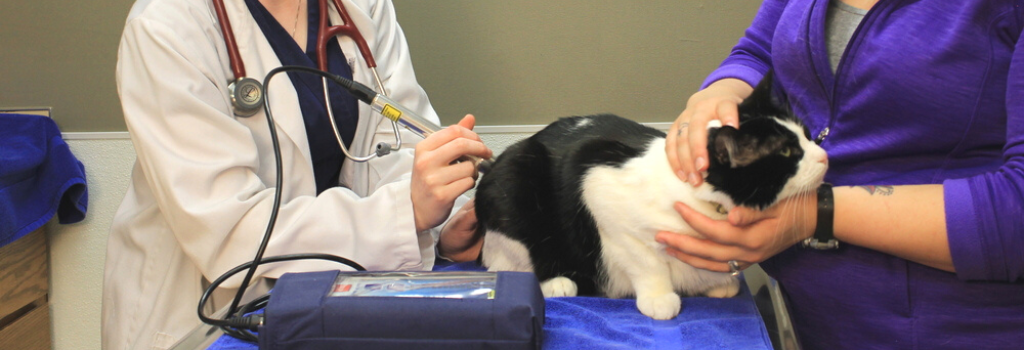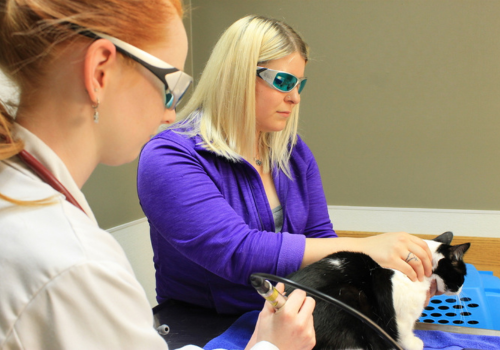If your cat has been in pain due to an acute or chronic condition that hasn’t responded well to more traditional veterinary treatments, your veterinarian may have recommended feline laser therapy. As this isn’t something you likely heard of as an option for cats very often. It may seem like something out of a science fiction movie, but there are many great benefits of this futuristic type of treatment.
Here at Miller Place Animal Hospital, we believe pet care information should come straight from veterinarians and not Dr. Google. That’s why we’ve taken FAQs on laser therapy for cats and answered them as thoroughly as possible. Please keep in mind that while the information below is factually correct, it’s always best to discuss your cat’s healthcare needs with your veterinarian. If you need a vet and you are in Miller Place, NY, we can help! Schedule your cat’s first appointment by reaching out to us at (631) 744-2050.
What is cat laser therapy, and how is it used?
Laser therapy is quite literally putting light into the body, and this light is absorbed by the cells in the body. And in fact, it goes into the mitochondria, which is the little engine that runs each cell, and the mitochondria are where energy is produced that makes the cell work. We apply the light to the cat. We shine a laser light into the cat, so it's not a de-focused light. As it’s incredibly focused light that goes into the area we're treating, it goes into the specific cells of those areas and gets absorbed by them. And the tiny engines (mitochondria) produce energy and get those cells back to work, which means that they're healing and functioning again.
How is laser therapy able to improve the health and wellbeing of my cat?
Laser therapy can improve the health and wellbeing of your cat in many ways. The first way is improving the cells’ ability to heal by increasing their function; by giving them more energy to function if they're old, tired, or diseased. And laser therapy also removes the inflammation and pain. The laser’s other function is to decrease inflammation, or essentially reducing cell death because when there is inflammation, many cells die at the site of the inflammation. That inflammation causes more inflammation, which causes more pain, which causes more degeneration and sick and tired cells. That's how laser therapy will improve whatever disease that we are trying to treat in your cat.
Why is it important to avoid self-diagnosing whether my cat is experiencing pain?
It’s challenging to tell when cats, in particular, are experiencing pain, which is why you need to bring them in and have a complete physical exam. They are very good at hiding pain. By the time someone that is not experienced at seeing cats every day notices that pain, your cat has probably been in pain for a very long time. And whatever disease that is ailing your cat has now possibly progressed to the point of no return. If you recognize that there is something wrong and may not know what it is and need to find out, take them to a veterinarian who will diagnose it for you, tell you what is going on, and how they can best help the cat.

What symptoms or conditions in my cat may be treatable with laser therapy?
The laser has many excellent uses. While the most frequent laser therapy use is likely for painful cats, we can also use it on cats that can't poop. They're constipated or obstipated. And that is a condition where the nerves to the colon - the large intestine - are not working very well for whatever reason. And most of the time, it is because there is some kind of spinal disease or something causing those nerves not to communicate well with the colon. Eventually, the muscles in the colon become flaccid, or “loosey-goosey” and not functioning to push the poop out of the body. Sadly, these cats can become very sick. Not only are they uncomfortable, but they are toxic because they have a lot of poop in them.
The first thing to do is handle that and get all of that out of them. But then we need to figure out how to improve the function of the colon. How do we make that colon work better? And we have some medications for that—some of these meds work, and some don't. And if they don't, then we have surgery. The laser comes in, often together with veterinary orthopedic manipulation, to increase that nerve function to the organ and stimulate the muscle cells in the colon itself to contract, move, and get things moving.
We can also treat allergies and musculoskeletal diseases. Arthritis in cats is very underdiagnosed. When we take x-rays in older cats, we often see hip dysplasia and hip arthritis. We may even see hip spinal problems. And these cats have been walking around like nothing was happening. And sometimes, it's very subtle. They stop grooming or, perhaps, they look groomed everywhere except their hips or something like that, where you know that something is wrong, but you think, “Oh, they’re just dirty.” Or you think, “I'm a bad parent because I didn't brush my cat,” or something like that when, in reality, it’s got nothing to do with that. The cat has been in some chronic pain that did not get diagnosed.
How long will it take for my cat to begin experiencing relief from their symptoms?
The cat should get some relief within a couple of weeks of laser therapy treatment. In two to three weeks, you should see improvement in the symptoms. Many of the alternative modalities that we use depend on how long the pet has been suffering from this condition. If it's been a long time, it's going to take longer for anything to kick in. And sometimes, we have to use traditional ways to get the animal stabilized and feel more comfortable and use the laser in addition to that to start getting some healing. There is a distinct difference between treating a condition and allowing healing to happen. Healing is different from treating, and our profession has become a treating profession. We treat diseases, but we need to ask what we can do to make the body heal.
That's where laser and orthopedic manipulation come in, and you should see an improvement. Most importantly, the goal of laser therapy would not just be to make the cat more comfortable but also to have them on fewer medications. And that's always welcomed by every cat owner. Many of them ask, "Is there anything that I can do so I don't have to put three or four medications into my cat and get myself worked up on the process?" Unfortunately, we don't have many cats that like to take medications, so this modality allows us to use fewer medications.
Is laser therapy capable of curing my cat?
It depends on the disease. In some cases, yes. However, most of the time, we're using it for treating a chronic condition, so we're using it to manage pain, re-establish good function, and get the cat comfortable without meds. So if that is a cure, that would be yes, but most of these cats are not cured. They need to have something continued for life, whether medications, something like laser, or veterinary orthopedic manipulation.

How many treatments might my cat require if laser therapy is recommended?
Again, that depends on what we're treating. If it's an acute injury, we can probably get it done with five to seven treatments. And in those cases, you often don't have to do anymore. Once the cat is comfortable and done, it's done. In the more common cases, we're dealing with chronic issues and cats that are on many meds. In those cases, we're probably looking at the maximum, which usually is about 14 treatments, to get the cat to a place where it's comfortable on minimal meds. At that point, we establish a frequency of treatment to maintain them. And in most cases, that means monthly treatments for the geriatrics—which I would call anything over 13 to 14 years old; they will probably need to come in every month to either get an adjustment, laser treatment, or both. Younger cats with fewer long-standing conditions might need treatment or a reminder, as some might call it, every three to four months.
Could my cat experience any side effects from laser therapy?
No, your cat won’t experience any side effects from laser therapy. And again, as with veterinary orthopedic manipulation, the main side effect is that you're getting the body into communication. You're improving the cell function at a cellular level. You're giving the cells more energy, so they’re producing more energy—you’re getting them back to work. That is the side effect. Now, there was a time when many thought, "Oh, you shouldn't be lasering an animal that has cancer." And the weird thing about cancer is that it doesn't behave like normal cells. First of all, when we're using lasers, we're using specific frequencies, and we’re plugging these numbers into the machine that communicates with a particular type of cell. And that cell and only that cell will absorb that frequency of light and produce energy. Since we're not communicating with the cancer cells, we're not sending them any energy.
What’s happening is when you treat a dog or a cat with cancer (side note: we do not use laser therapy to treat cancer), the side effect of using a laser is that if there is cancer, your animal will get stronger. Immune system cells are going to get stronger. They're going to produce more energy, and they're going to be better able to fight anything around them. Unfortunately, they will ultimately lose the battle with cancer, but what you're trying to do is you're trying to increase the function and the energy of the cells in the rest of the body compared to the cells in the cancer.
The side effect or benefit is that while you're treating, say, arthritis, you’re improving the entire body because many times, we will use immune system frequencies and something called parasympathetic stimulation. The parasympathetic system is a system that takes care of all your organs in the body. The sympathetic system is the one that contains the flight and fight reaction, which is always up when you're stressed or sick instead of taking care of the major organs in your body. So when we do that, the side effect is we're making a stronger body, and cells will be happier and more able to fight whatever is in there. In general, what we see is a much happier patient, whether they have cancer or not.
How will a veterinarian decide upon laser therapy as a treatment option for my cat?
Well, your veterinarian will decide on laser therapy for your cat usually through experience. We treat certain things all the time, and then we run into a brick wall type of situation—we’ve tried several things and nothing seems to be working. Then it's time to expand your horizons and look at other options, and the laser would be one of those alternatives. With cats, it is often because they won't take pills. And how do you get them comfortable if they're not going to take pills? So this is a modality that can be used that can get cats really comfortable, really fast.
The other thing is that pills may be contra-indicated. For instance, cats do very well with steroids compared to dogs, and they can tolerate them a lot better than dogs can. But if you have a fat diabetic cat, you can't give that cat steroids. If that cat is uncomfortable, though, what are you going to do? You're going to need to think about other options. And again, other pain medications are not as well tolerated by cats, and we have laser and veterinary orthopedic manipulation to help them. And because of the frequencies that we use, we can also improve the diabetic state or whatever else the cat is suffering from by giving that body back its power to heal itself.
Most of the time, with cats with chronic issues, your veterinarian will want to see the medical records before seeing your cat in order to do a full diagnostic scenario of the options. Is laser going to be a good plan for this cat or not? And do we need to add veterinary orthopedic manipulation? Or is laser the only thing that we need to consider at this point? Don’t be afraid to ask for these treatments, and we will tell you if they will work for your cat. And certainly, if we think it's not going to work, we're not going to recommend it.
Do you still have questions about cat laser therapy? We can help! As veterinarians in Miller Place, NY, we’re here to discuss your cat’s situation, determine if laser therapy is a good option for your faithful fur friend, and address any questions or concerns you may have. Send an email to [email protected] or call (631) 744-2050 today.



